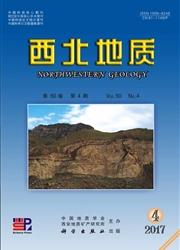

 中文摘要:
中文摘要:
东杜奥巴金矿床位于中塔吉克斯坦贵金属成矿带内,是乔列金矿田已探明的4处大型金矿床之一,矿床受区域推覆构造控制明显,时空上与区域发育的古生代浅变质沉积岩系有关;黄铁矿和毒砂是最主要的载金矿物,自然金呈包裹体赋存于成矿期黄铁矿和毒砂矿物中。区域上基底地层与上覆盖层在晚古生代时期经历过3次大规模的构造重组:隆升阶段-造山阶段-晚华力西期造山的最终阶段,并导致矿床当前的时空就位。含碳浅变质碎屑岩带和钠长石化花岗斑岩脉与矿体的成因及时空分布密切相关,矿床成因类型是与早古生代黑色岩系沉积变形、变质及改造作用有关的浅变质碎屑岩型和接触交代蚀变岩型金矿床。
 英文摘要:
英文摘要:
The Dongduaoba gold deposit,located in the precious metal metallogenic belt of Middle Tajikistan,is one of four large-sized gold deposits that had been discovered in Qiaolie gold field.This deposit is obviously controlled by regional nappe structure,which has a space-time relationship with Paleozoic shallow metamorphic sedimentary rock series.Pyrite and arsenopyrite serve as the main gold bearing minerals in this deposit.Native goldinclusions are occurred with in metallogenicpyrite and arsenopyrite minerals.Regionally,the basement strata and upper cap have experienced three times of large-scale structural reorganization in Late Paleozoic era,that is,uplift stage,orogenic stage and final period of Late Variscan stage structure(orogeny),which leaded to the current time-space emplacement of this deposit.Carbonous epimetamorphic clastic rock belt and albitization granite porphyry vein are closely related to the origin and spatiotemporal distribution of gold ore body.The genetic types of gold deposits are epimetamorphic clastic rock type and contact metasomatic alteration rock type,which are related with the deformation,metamorphism and reformation of Early Palaeozoic black rock series.
 同期刊论文项目
同期刊论文项目
 同项目期刊论文
同项目期刊论文
 Petrogenesis of late Paleozoic tholeiitic, Nb-enriched, calc-alkaline and adakitic rocks in southwes
Petrogenesis of late Paleozoic tholeiitic, Nb-enriched, calc-alkaline and adakitic rocks in southwes Molybdenite Re-Os isotope age of the Donggebi Mo deposit and the Indosinian metallogenic event in ea
Molybdenite Re-Os isotope age of the Donggebi Mo deposit and the Indosinian metallogenic event in ea Alteration information extraction using improved relative absorption band-depth images, from HJ-1A H
Alteration information extraction using improved relative absorption band-depth images, from HJ-1A H 期刊信息
期刊信息
